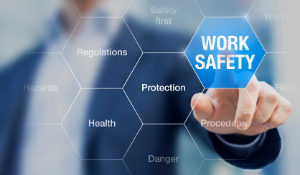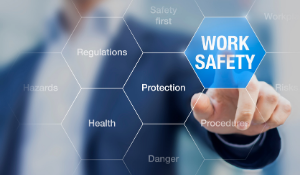Prevent It


Do You Know the Four Elements of an Effective Workplace Safety Program?
 Business owners and safety managers share a common goal – nobody wants to see workers get hurt on the job. Musculoskeletal disorders and injuries are costly to both employees and their workplace. An injured worker must be replaced, perhaps with someone not as well trained or proficient, resulting in lower productivity and/or quality. But a strong workplace safety culture – one with a proactive approach to managing employee wellbeing -- can minimize worker injuries and absences while also enhancing employee confidence, productivity, and retention.
Business owners and safety managers share a common goal – nobody wants to see workers get hurt on the job. Musculoskeletal disorders and injuries are costly to both employees and their workplace. An injured worker must be replaced, perhaps with someone not as well trained or proficient, resulting in lower productivity and/or quality. But a strong workplace safety culture – one with a proactive approach to managing employee wellbeing -- can minimize worker injuries and absences while also enhancing employee confidence, productivity, and retention.
The Value of Safety Programs
You can build a positive safety culture by designing and implementing an effective workplace safety program. As part of an organization-wide focus on safety and worker wellbeing, a safety program is a set of policies and initiatives that shield your employees from workplace hazards, define safety responsibilities and procedures, and document proper responses to injuries and emergencies. With the right policies in place, companies can transform the way managers and employees approach workplace safety.
According to OSHA, the best workplace safety programs include four essential elements:
- Management commitment combined with employee involvement;
- A thorough analysis of the worksite;
- Hazard prevention and control; and
- Safety and health training.
Workplace safety programs with all four elements strengthen your organization’s compliance with OSHA regulations while keeping workers healthy. An effective safety program can motivate employees to adopt safer work practices and report minor musculoskeletal disorders before they worsen into debilitating injuries. It can even lead workers to recommend job improvements and report workplace hazards.
Everybody Shares Responsibility for Safety
A commitment to workplace safety must start at the top, with the management team making worker wellbeing a top priority and communicating it across the organization. Then managers need to “walk the walk” and lead by example, committing to open, candid dialogues with workers, set up employee safety training, and establish realistic goals and responses to hazardous working conditions.
An organization’s workforce safety program connects everyone to the common goal of keeping employees healthy and productive. By implementing proactive safety measures, an organization can build trust between workers and management and further strengthen their positive safety culture.
However, managers need to watch for mixed messages that may lead employees to believe their safety is not considered important. For example, if workers are reprimanded for reporting minor musculoskeletal disorders or take a needed sick day, then executive communications about workplace safety and established safety practices may be ignored.
Workplace Safety – Protecting Both Workers and Businesses
Strategic risk management and workplace safety are critical to a company’s success. An organization’s safety programs protect its most important asset — its employees — and can result in measurable bottom-line operational and cost benefits. Creating a safer workplace—and prioritizing employee wellbeing—can also prevent safety incidents and improve their morale.
Workwell helps organizations create a world-class safety culture by delivering comprehensive musculoskeletal health programs to keep your employees safe, healthy, and productive. We are experts in preventing and treating sprains, strains, and back pain.
Select a topic
- View all topics
- WorkWell
- Safety Culture
- Onsite PT Clinics
- Ergonomics
- Injury/Illness Prevention
- Employee Wellness
- MSK
- Industry News
- POET
- Safety
- Managed Services
- Manufacturing
- Functional Job Descriptions
- Onsite PT
- FJD
- Post Offer Employment Training
- Provider Network
- Blog
- Events
- Featured
- OSHA
- Work Readiness
- Company News
- Job Coaching
- MSK Strategy
- Musculoskeletal
- PT Solutions Employee
- Presenteeism
- Push/Pull
- Recruitment
- Training
- Trust
- Worksite Rounds
Subscribe to Our Blog
Practical tips focused on workplace injury prevention.
Featured Posts
postsTags [BlogPost 178613021575 Shift to Prevention and End the Game of Whack-a-Mole, BlogPost 125116526205 Why now is the time for a Managed Onsite MSK Clinic]
.png)

